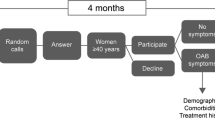Abstract
Introduction and hypothesis
The aetiology of the overactive bladder (OAB) symptom complex is still poorly understood. In order to obtain further insight, the prevalence and predictors of the symptoms included in OAB, that is urgency, urgency incontinence (UUI), frequency and nocturia, were investigated in a sample of nonpregnant nulliparous women.
Methods
A national, postal and web-based survey of OAB symptoms was conducted in women aged 25–64 years (n = 9,197). Crude prevalence and prevalence adjusted according to body mass index (BMI) were calculated from a logistic regression model to evaluate the prevalence of OAB.
Results
The response rate was 52%. The prevalence of urgency, bothersome urgency, UUI, and nocturia, but not daytime frequency, increased consistently with advancing age and increasing BMI. Urgency was associated with BMI, age ≥45 years, nocturia, and daytime frequency of eight or more micturitions. Daytime urinary micturition frequency was not affected by age either in women with OAB or in women without OAB. Bothersome OAB affected almost half of the woman in the oldest age group and was strongly associated with nocturia of two or more micturitions and OAB with UUI.
Conclusions
There were contrasting changes in the prevalence of the different symptoms included in OAB. With increasing age and BMI, the prevalence of nocturia, urgency and UUI increased, while daytime frequency remained stable. These findings are of importance as the primary endpoint for the evaluation of drug therapies for OAB has often been daytime urinary frequency.
Similar content being viewed by others
References
Haylen BT, de Ridder D, Freeman RM, Swift SE, Berghmans B, et al. An International Urogynecological Association (IUGA)/International Continence Society (ICS) joint report on the terminology for female pelvic floor dysfunction. Int Urogynecol J. 2010;21:5–26. doi:10.1007/s00192-009-0976-9.
Kelleher CJ, Cardozo LD, Khullar V, Salvatore S. A new questionnaire to assess the quality of life of urinary incontinent women. Br J Obstet Gynaecol. 1997;104:1374–9.
Coyne KS, Sexton CC, Irwin DE, Kopp ZS, Kelleher CJ, Milsom I. The impact of overactive bladder, incontinence and other lower urinary tract symptoms on quality of life, work productivity, sexuality and emotional wellbeing in men and women: results from the EPIC study. BJU Int. 2008;101:1388–95.
Vaughan CP, Johnson TM 2nd, Ala-Lipasti MA, et al. The prevalence of clinically meaningful overactive bladder: bother and quality of life results from the population-based FINNO study. Eur Urol. 2011;59:629–36.
Milsom I, Abrams P, Cardozo L, Roberts RG, Thüroff J, Wein AJ. How widespread are the symptoms of an overactive bladder and how are they managed? A population-based prevalence study. BJU Int. 2001;87:760–6.
Stewart WF, Van Rooyen JB, Cundiff GW, et al. Prevalence and burden of overactive bladder in the United States. World J Urol. 2003;20:327–36.
Irwin DE, Milsom I, Hunskaar S, et al. Population-based survey of urinary incontinence, overactive bladder, and other lower urinary tract symptoms in five countries: results of the EPIC study. Eur Urol. 2006;50:1306–14.
Coyne KS, Sexton CC, Thompson CL, et al. The prevalence of lower urinary tract symptoms (LUTS) in the USA, the UK and Sweden: results from the epidemiology of LUTS (EpiLUTS) study. BJU Int. 2009;104:352–60.
Milsom I, Coyne KS, Nicholson S, Kvasz M, Chen CI, Wein AJ. Global prevalence and economic burden of urgency urinary incontinence: a systematic review. Eur Urol. 2014;65:79–95.
Abrams P. Urgency: the key to defining overactive bladder. BJU Int. 2005;96(Suppl 1):1–3.
Zhang L, Zhu L, Xu T, et al. A population-based survey of the prevalence, potential risk factors, and symptom-specific bother of lower urinary tract symptoms in adult Chinese women. Eur Urol. 2015;68:97–112.
Sandvik H, Hunskaar S, Seim A, Hermstad R, Vanvik A, Bratt H. Validation of a severity index in female urinary incontinence and its implementation in an epidemiological survey. J Epidemiol Community Health. 1993;47:497–9.
Hannestad YS, Rortveit G, Sandvik H, Hunskaar S. A community-based epidemiological survey of female urinary incontinence: the Norwegian EPINCONT study. Epidemiology of Incontinence in the County of Nord-Trondelag. J Clin Epidemiol. 2000;53:1150–7.
Tegerstedt G, Miedel A, Maehle-Schmidt M, Nyren O, Hammarstrom M. A short-form questionnaire identified genital organ prolapse. J Clin Epidemiol. 2005;58:41–6.
Jorge JM, Wexner SD. Etiology and management of fecal incontinence. Dis Colon Rectum. 1993;36:77–97.
Tikkinen KA, Johnson TM 2nd, Tammela TL, et al. Nocturia frequency, bother, and quality of life: how often is too often? A population-based study in Finland. Eur Urol. 2010;57:488–96.
Madhu C, Coyne K, Hashim H, Chapple C, Milsom I, Kopp Z. Nocturia: risk factors and associated comorbidities; findings from the EpiLUTS study. Int J Clin Pract. 2015;69:1508–16.
Rothman KJ, Greenland S, Lash TL. Design strategies to improve study accuracy, restriction. In: Modern epidemiology. 3rd ed. Philadelphia: Lippincott Williams & Wilkins; 2008. p. 168–82.
Milsom I, Altman D, Cartwright R, et al (2013) Epidemiology of urinary incontinence (UI) and other lower urinary tract symptoms (LUTS), pelvic organ prolapse (POP) and anal (AI) incontinence. In: Abrams P, Cardozo L, Khoury H, Wein A, editors. Incontinence. Health Publications Ltd, Paris.
Author information
Authors and Affiliations
Corresponding author
Ethics declarations
Conflicts of interest
D.R. has received honoraria from Astellas, Allergan, Ixaltis, Ferring and Pfizer for consultancy, speaker and/or trial participation. S.Å. has no competing interests. A.W. has received honoraria from Astellas Pharma, Pfizer Corp and SCA. C.C. has received honoraria from Allergan, Astellas, Medtronic, Ono and Recordati for consultancy, speaker and/or trial participation. I.M. has received honoraria from Allergan, Astellas, Pfizer and SCA for consultancy, speaker and trial participation. M.G. has received honoraria from Astellas for speaker participation.
Funding
The study was supported by a National LUA/ALF grant no. 11,315, grants from The Göteborg Medical Society and Hjalmar Svenssons Fund, Alice Swenzons Fund and The Healthcare Committee, Region Västra Götaland. The funding sources had no role in study design, data analysis, data interpretation, or writing of the report.
Rights and permissions
About this article
Cite this article
Robinson, D., Åkervall, S., Wagg, A. et al. Prevalence and predictors of overactive bladder in nonpregnant nulliparous women below 65 years of age. Int Urogynecol J 29, 531–537 (2018). https://doi.org/10.1007/s00192-017-3435-z
Received:
Accepted:
Published:
Issue Date:
DOI: https://doi.org/10.1007/s00192-017-3435-z




